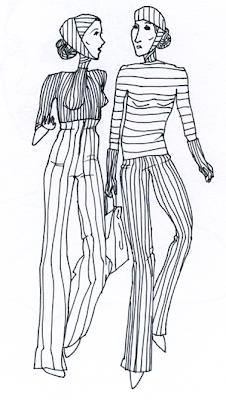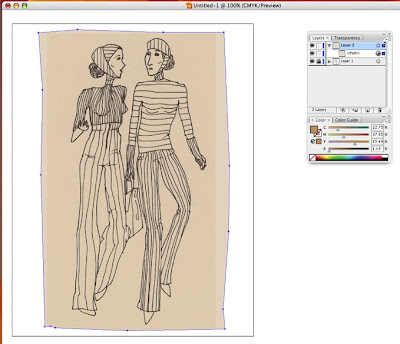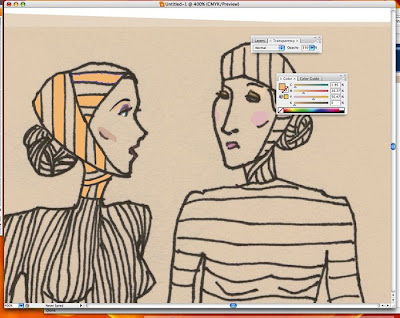 click on the image to see detail
click on the image to see detail3/28/08
shading
 click on the image to see detail
click on the image to see detail3/27/08
new drawing
I really love the look of water color, but find it very hard to control and very easy to mess up.
I must admit I've ruined a few drawings before while working with watercolors, when I realized that a wash has flown into a another that was not yet dry.
I have an OCD when it comes to colors so I drive myself crazy with watercolor paints since the washes can be so unpredictable.
Illustrator makes it easy to create drawings in this style and I am able to change the color scheme in seconds.
It's hard to believe I didn't know Illustrator at all just a few years ago, now I couldn't live without it..
Now if only life came with a command+z button!
Anyway...
Here is the sketch in the beginning stage:
 A simple line drawing done in graphite, then ink, scanned in at a high resolution and cleaned up. I make sure here to save the drawing with the extension of .png because it preserves line work better than .jpegs.
A simple line drawing done in graphite, then ink, scanned in at a high resolution and cleaned up. I make sure here to save the drawing with the extension of .png because it preserves line work better than .jpegs.I then pull the drawing into illustrator and lock that layer. On a new layer, I use the pen tool to put down a "wash" of color over the entire image. I set the transparency to about 30-40% for that shape.
 It's smart to name layers if the illustration is complicated and requires a lot of different shapes in case you want to go back and make changes.
It's smart to name layers if the illustration is complicated and requires a lot of different shapes in case you want to go back and make changes. Leaving the background color as the skin tone, I locked that layer and created a new one. On the new layer, I began mapping out shapes using the pen tool, making sure not to cover up the line work. If I want the background wash to show through and also to soften the intensity of the the color, I make the shapes more transperent. (for ex., the cheeks) And if I want the colors to be more brilliant and bright, I use very little transparency or leave it at 100% (like I did for the orange).
Leaving the background color as the skin tone, I locked that layer and created a new one. On the new layer, I began mapping out shapes using the pen tool, making sure not to cover up the line work. If I want the background wash to show through and also to soften the intensity of the the color, I make the shapes more transperent. (for ex., the cheeks) And if I want the colors to be more brilliant and bright, I use very little transparency or leave it at 100% (like I did for the orange).It's also good to experiment with different colors and transparencies to see how they create color combinations in layers. With a drawing made in this style, I continue to create shapes and work out a harmony between the colors, constantly changing and tweaking until it's satisfactory.
More on this later during the week!
3/13/08
new illustration
 A few layers of Prismacolor.
A few layers of Prismacolor.I realized that most of my Prismacolor markers are almost out of marker juice a few days ago. That means its time to make my monthly trip to the art supply store to replenish my art bin and buy the whole darn place again. Also on the list... color PLAKA! I'm truly obsessed with it. It's a milk-based paint that dries to the most perfect velvety matte finish and shows no brushmarks. It's kind of like gouache but much easier to handle.
* I wanted to mention that I was too lazy to look for my Microns for the b&w sketch so I used a regular Uniball pen and regretted it. The water in the markers sent the pen ink washing around and mucking up my drawing. That is why you're not seeing a scan of it. ; )
When using water-based pigment, you must erase all graphite and use a water-proof ink to keep your colors brilliant.


